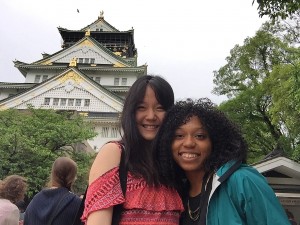
Credit: Cheng
Part I:
It has been a week since we landed in Japan. I still cannot believe how much we have experienced together and how much more we are going to explore. Our today’s itinerary is quite intense. Starting the day with a cup of iced coffee (Of course having some troubles reading the menu and ordering the drink), we are going to another museum, Yasukuni shrine, a famous omelette rice restaurant and finally a temple (also looks like a research facility to me).
The Historical Materials Hall for the Wounded and Sick Retired Soldiers really shocked me. Following the timeline and instruction, my emotion rose and fell with the images and words. I saw pictures of the conscription process and the letters soldiers wrote to their families. The reality seems so far but so close at the same time. When I was younger, most of people around me shared the traditional and typical perspectives of Chinese. Without objectively discussing the truth, they imprinted the negative figure of Japan and Japanese into the mind of younger generation. However, my parents were relatively open-minded and they encouraged me to develop individual thinking and rejected the influence of bias. The letters written in Japanese, which have some similar characters I understand, brought me back to those days when people’s lives and values were questionable. These soldiers were forced to leave their loved ones and joined the front line. Most of them did not make their way back. In their letters, they expressed both their desperation and hope. Facing danger everyday, yet hoping for the day to come, they are absolutely the victims of wars. Back to a more personal level, I sympathize people who sacrificed their lives for the prosperity of the country, but I start doubting people who held political power and made the cruel decisions. This museum is really meaningful and I learned a lot from the documents.
While I was still soaking in my own thoughts and reflection of the museum, we walked from the museum to the Yasukuni Shrine. It is located in the middle of Tokyo and it is one of the biggest shrines in Japan. I knew this shrine before from news and it is a relatively controversial shrine in Chinese’s perspective. Before we went there, I have heard my friend’s opinion towards the shrine. For some people, Yasukuni Shrine is the place that houses all the war criminals, whereas for other people, it gives their hero peace and honor. I tried to be as open-minded as I can to receive a different aspect. The museum introduces the long history of Japan and gradually moves to the modern time. Even though we did not that much time to go in every detail, I paid more attention on the introduction of WWII and the conflicts between China and Japan. Surprisingly, I personally think the description of the war was more objective than I expect. They may skip some battles that were emphasized by my Chinese history teachers, but they do admit the damage wars brought to both citizens of their own and others. At the end of the tour, I bought a book that introduces the function of Yasukuni Shrine and the history of it. I will read it later and make myself more knowledgeable.
The highlight of the day came after a nice lunch. We went to a temple and listened lectured hosted by professors and researchers. I was impressed by their passion and work they have done. The lantern float festival is just so amazing and beautiful for people to memorize the past and hold accountability for the future. The topic of peace is interesting because I never deeply think of how I can contribute to the peace of our society. When we asked the question of how do they define peace, one of the researchers’ answer really touched my heart. He said, “The ultimate peace is not only external peace, but more of the internal peace.” It is such a philosophical response, but I feel something rising from my heart. Without correctly facing our own struggle, solving it, we can never achieve the balance. Furthermore, a person without internal peace can only fake the external peace. Starting from retrospect ourselves, we will more capable of dealing outer conflicts. After the presentation, we had wonderful dinner together. Getting to know them personally, I was able to understand their motivation more and that made me wonder how I can take action to follow their lead as well as how my actions affect people around me.
Part II:
Except for the serious part, Japan is also super FUN. The most impressive memory I have during the day was my adventure of the fancy omelette rice restaurant’s kitchen. I was wandering around and checking out the frying pan they use to make omelette. Their manager came to me and asked if I need any help. I expressed my interest in cooking and she eagerly invited me to take a tour in their kitchen. Taking out the cute frying pan, the chief told me that it took him two to three years to roll a perfect omelette. Another person (looks like the main chief’s protégé) showed me how they practice using a bag of salt. I was amazed by how enthusiastic they were. “In my opinion, most of foreigners don’t enjoy this special omelette that much. However, you are different!” I felt flattered and grateful. As a customer, I appreciate how much they weigh my appreciation and I think my appreciation also inspires them to devote more to their career.
After coming to Japan, I have encountered many people who do not speak either English or Chinese, but while I was trying my best to communicate with them, they showed full respect to me. It is a country with manner. I was moved and spent great time in Japan.
